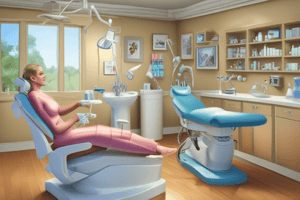Podcast
Questions and Answers
Which classification of occlusion is based on the relationship of the bone of the maxilla to the bone of the mandible?
Which classification of occlusion is based on the relationship of the bone of the maxilla to the bone of the mandible?
- Class III malocclusion
- Skeletal classification (correct)
- Type I occlusion
- Angle's classification
What is the name given to the classification based on the relationship of the teeth of the mandible to the teeth of the maxilla?
What is the name given to the classification based on the relationship of the teeth of the mandible to the teeth of the maxilla?
- Type III occlusion
- Mandibular classification
- Class II malocclusion
- Dental classification (correct)
In occlusal classification, what is referred to as skeletal classification?
In occlusal classification, what is referred to as skeletal classification?
- Based on bone relationship
- Malocclusion classification (correct)
- Dental classification
- Type II occlusion
Which of the following is NOT one of the two basic classifications of occlusion?
Which of the following is NOT one of the two basic classifications of occlusion?
What causes pulp exposure according to the text?
What causes pulp exposure according to the text?
When is occlusion most stable?
When is occlusion most stable?
Which classification system is based primarily on the relationship of the permanent first molars?
Which classification system is based primarily on the relationship of the permanent first molars?
In skeletal classification, which class involves a protruded mandible?
In skeletal classification, which class involves a protruded mandible?
Which class in skeletal classification describes a normal relationship between the maxilla and mandible?
Which class in skeletal classification describes a normal relationship between the maxilla and mandible?
What is the defining feature of a Class II skeletal classification?
What is the defining feature of a Class II skeletal classification?
Which classification system is the most popular one used in dentistry today?
Which classification system is the most popular one used in dentistry today?
Is it possible to have different classifications on each side according to Angle's classification system?
Is it possible to have different classifications on each side according to Angle's classification system?
In an ideal Class I occlusion relationship, where are the lingual cusps of the maxillary teeth positioned in relation to the mandibular teeth?
In an ideal Class I occlusion relationship, where are the lingual cusps of the maxillary teeth positioned in relation to the mandibular teeth?
According to Angle's classification, what indicates a Class II occlusal relationship?
According to Angle's classification, what indicates a Class II occlusal relationship?
What characterizes a Class I occlusal relationship based on occlusal classification?
What characterizes a Class I occlusal relationship based on occlusal classification?
What is the position of maxillary teeth in an ideal Class I occlusion?
What is the position of maxillary teeth in an ideal Class I occlusion?
According to occlusal classification, where should the buccal cusps of maxillary crown be positioned in relation to the mandibular teeth?
According to occlusal classification, where should the buccal cusps of maxillary crown be positioned in relation to the mandibular teeth?
What defines an Angel's class II occlusal relationship?
What defines an Angel's class II occlusal relationship?
Study Notes
Classification of Occlusion
- Skeletal classification is based on the relationship of the bone of the maxilla to the bone of the mandible.
- Dental classification is based on the relationship of the teeth of the mandible to the teeth of the maxilla.
Angle's Classification System
- This system is based primarily on the relationship of the permanent first molars.
- It is the most popular classification system used in dentistry today.
- It allows for different classifications on each side.
- A Class I occlusal relationship is characterized by the lingual cusps of the maxillary teeth positioned in the buccal groove of the mandibular teeth.
- A Class II occlusal relationship is characterized by the maxillary teeth being positioned anterior to the mandibular teeth.
- An ideal Class I occlusion is defined by the maxillary teeth being positioned slightly anterior to the mandibular teeth.
- In an ideal Class I occlusion, the buccal cusps of the maxillary crown should be positioned in the buccal groove of the mandibular teeth.
Skeletal Classification
- Class I skeletal classification describes a normal relationship between the maxilla and mandible.
- Class II skeletal classification is characterized by a retrognathic mandible (maxillary teeth positioned anterior to the mandibular teeth).
- Class III skeletal classification is characterized by a protruded mandible.
Occlusion Stability
- Occlusion is most stable when the teeth are in a position of maximum intercuspation.
Other Facts
- Pulp exposure is caused by excessive wear or decay.
- There is no classification system based on the relationship of the pulp to the surrounding tissues.
Studying That Suits You
Use AI to generate personalized quizzes and flashcards to suit your learning preferences.
Description
Test your knowledge on the skeletal classification of occlusal relationships into Class I, Class II, and Class III based on the position of the maxilla and mandible. Identify the characteristics of each class.




